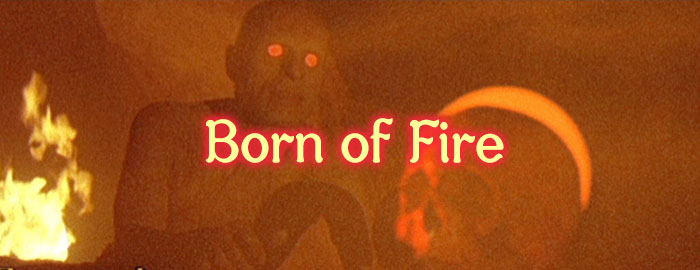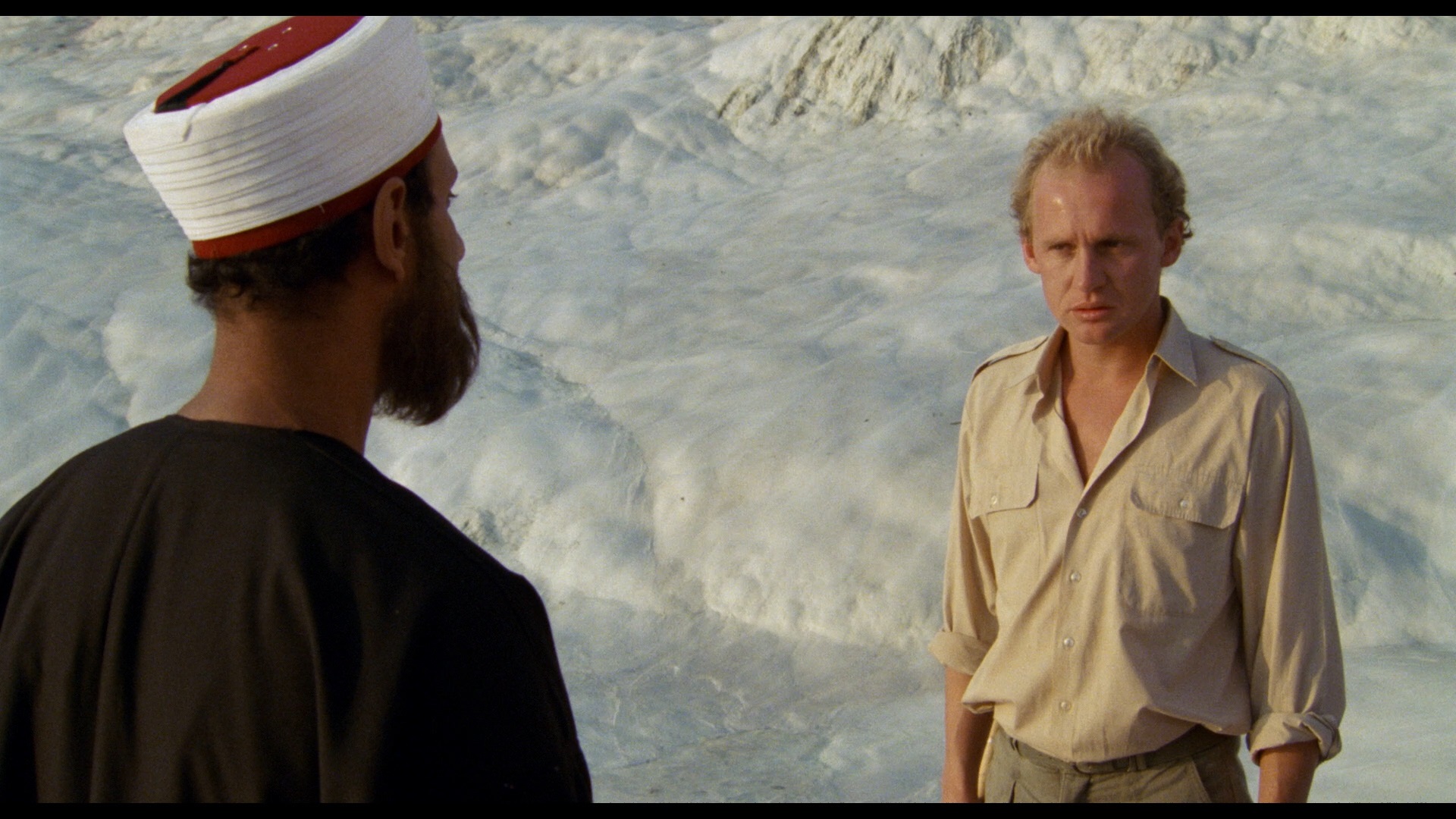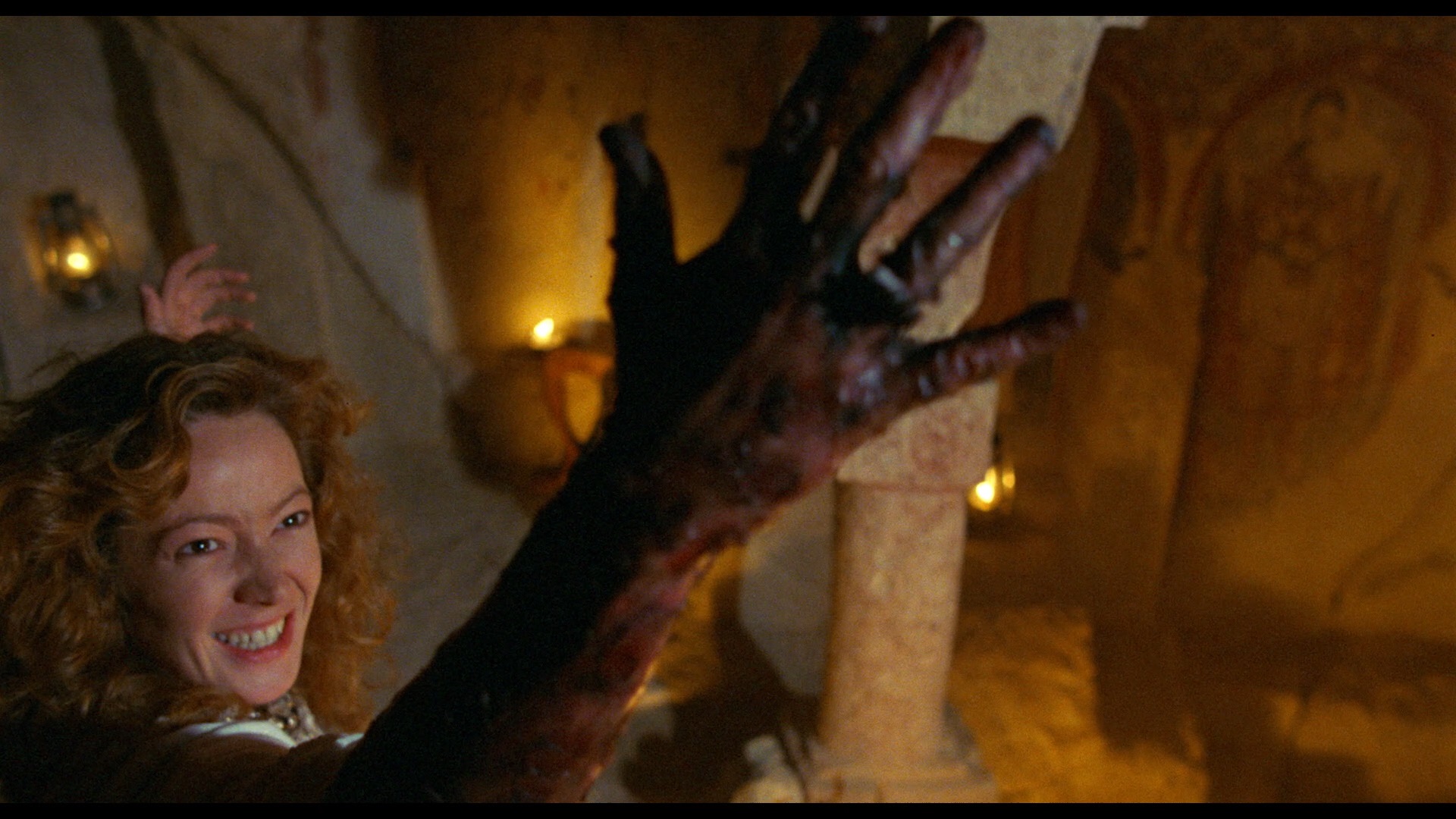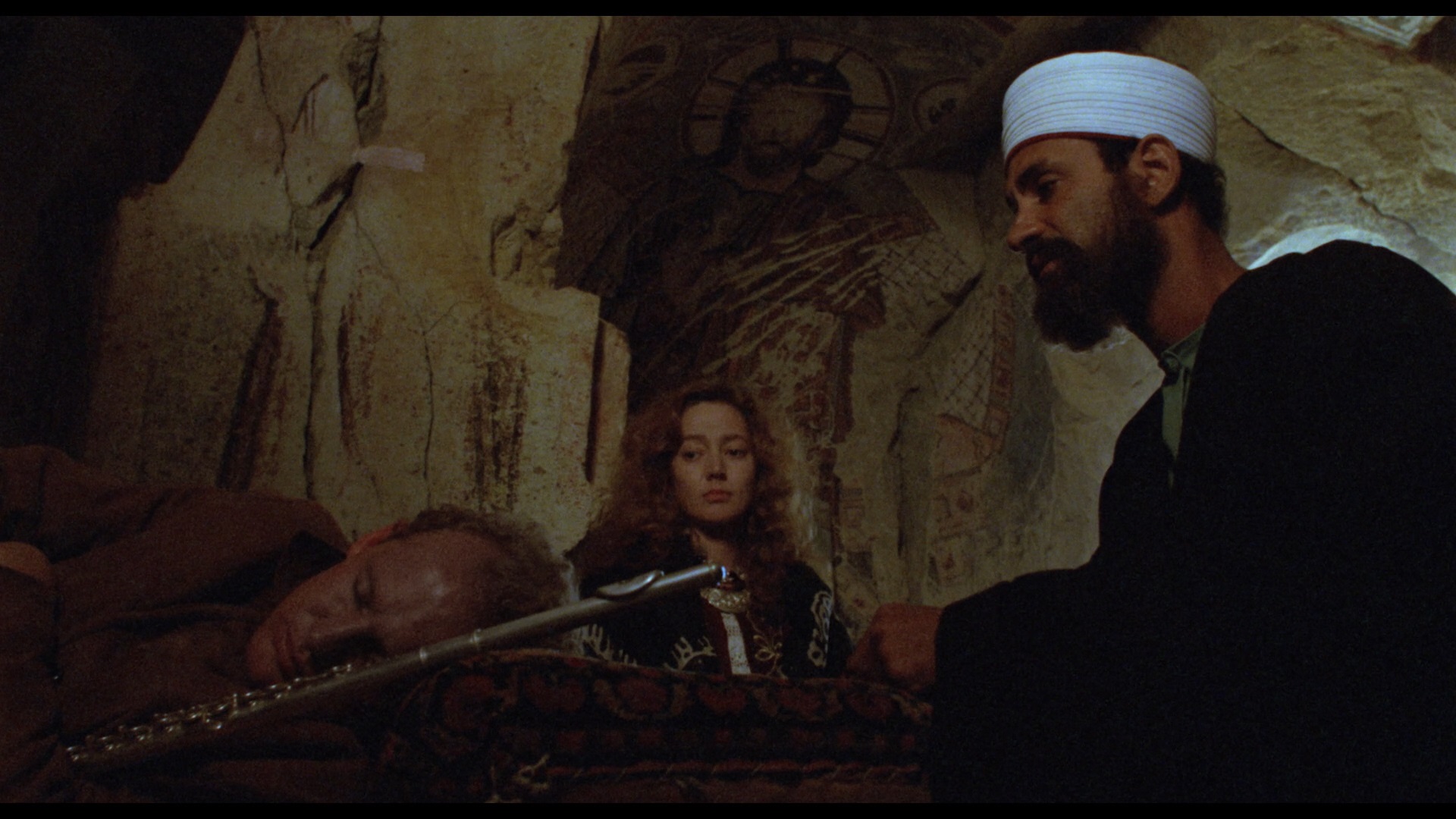


 violent solar activity including
violent solar activity including  what appears to be a skull-like eclipse causes strange eruptions and nightmarish visions in targeted locations on Earth, a nameless female astronomer (The Draughtsman's Contract's Crowley) takes her findings to a tormented flutist, Paul (Firth), whose own nightmares appear to be related to his father, who died before his son's birth while seeking an enigmatic, possibly malefic Eastern entity known as the Master Musician (Oh-Tee). Together in Turkey they experience increasingly bizarre encounters involving djinns, dervishes, and the birth of a giant, slimy insect-like beast by our heroine.
what appears to be a skull-like eclipse causes strange eruptions and nightmarish visions in targeted locations on Earth, a nameless female astronomer (The Draughtsman's Contract's Crowley) takes her findings to a tormented flutist, Paul (Firth), whose own nightmares appear to be related to his father, who died before his son's birth while seeking an enigmatic, possibly malefic Eastern entity known as the Master Musician (Oh-Tee). Together in Turkey they experience increasingly bizarre encounters involving djinns, dervishes, and the birth of a giant, slimy insect-like beast by our heroine.
 increased commercial exposure of artists like Jodorowsky and Arrabal should make this much easier to digest now, and it's certainly among the classiest and most visually ravishing films chosen by Mondo Macabro in its quest to bring the world's most mind-bending titles to a wider audience.
Among the
increased commercial exposure of artists like Jodorowsky and Arrabal should make this much easier to digest now, and it's certainly among the classiest and most visually ravishing films chosen by Mondo Macabro in its quest to bring the world's most mind-bending titles to a wider audience.
Among the  biggest surprises on the label's 2009 DVD is the participation of Firth, an actor riding high at the time after Broadway successes like Amadeus and Equus (and later seen on the excellent TV series Spooks, better known to Yanks as MI-5). Fortunately he contributes a fascinating video interview (12m24s) on the DVD to explain a bit about his career choices at the time (he turned down a lot of Hollywood projects, a decision about which he now feels conflicted) and his interest in the source material and director Dehlavi, who largely improvised the film around a framework of concepts to which he'd been exposed since childhood. These influences are explained further in an interview with the director, who admits in retrospect he might have been better following his true love of painting and expounds upon some of the magical ideas he wanted to explore wit4h this film. The challenges of shooting in Turkey (particularly the covert filming of some of the more unclothed sequences) also provides several anecdotal highlights. Last up is actor Shaban (who plays "The Silent One," a mysterious dervish) who talks more about his career
biggest surprises on the label's 2009 DVD is the participation of Firth, an actor riding high at the time after Broadway successes like Amadeus and Equus (and later seen on the excellent TV series Spooks, better known to Yanks as MI-5). Fortunately he contributes a fascinating video interview (12m24s) on the DVD to explain a bit about his career choices at the time (he turned down a lot of Hollywood projects, a decision about which he now feels conflicted) and his interest in the source material and director Dehlavi, who largely improvised the film around a framework of concepts to which he'd been exposed since childhood. These influences are explained further in an interview with the director, who admits in retrospect he might have been better following his true love of painting and expounds upon some of the magical ideas he wanted to explore wit4h this film. The challenges of shooting in Turkey (particularly the covert filming of some of the more unclothed sequences) also provides several anecdotal highlights. Last up is actor Shaban (who plays "The Silent One," a mysterious dervish) who talks more about his career  and the basic outline of the plot as it was originally presented. Pete Tombs contributes another outstanding, illuminating set of notes about the film (you really might want to read them before viewing the feature) and a dupey '80s Vidmark trailer used to promote the tape release. As for the transfer of the film
and the basic outline of the plot as it was originally presented. Pete Tombs contributes another outstanding, illuminating set of notes about the film (you really might want to read them before viewing the feature) and a dupey '80s Vidmark trailer used to promote the tape release. As for the transfer of the film  itself, it's a sensational upgrade from the scarce prior releases and finally does justice to the rich, often startling visuals, ranging from arid mountains and richly-textured caves to glistening ice formations.
itself, it's a sensational upgrade from the scarce prior releases and finally does justice to the rich, often startling visuals, ranging from arid mountains and richly-textured caves to glistening ice formations.  Werner Herzog. A new, different Dehlavi interview, "Playing with Fire" (18m8s), lays out the groundwork for how this film emerged
Werner Herzog. A new, different Dehlavi interview, "Playing with Fire" (18m8s), lays out the groundwork for how this film emerged  from his past work and more than a little bit of political turmoil, with TV commercials keeping him going in the interim. He also reveals which part was the most difficult to cast, and it's not the one you'd expect-- and there's even an anecdote about trying to cast Jack Palance, which would have resulted in a markedly different film! Shaban appears for a new interview in "The Silent One Speaks" (34m39s) for a comprehensive account of how he got the role (despite being convinced he'd be passed over) and was attracted to the deep, more abstract qualities that he finds are too rare in films now. He also explains how he ended up being transported around the imposing terrain and shares tales about some of the wilder moments during shooting, including a perilous cave fire. "In Another World" (16m52s) is a very welcome new interview with composer Colin Towns, who had already provided one of the best horror scores of all time with The Haunting of Julia and got to stretch himself with a world of unusual instruments and a heavy emphasis on the flute. The 2009 Firth interview is also carried over here, and a better presentation of the U.S. trailer is included along with separate galleries for location photography (48 images) from Saban's collection and a batch of (NSFW) stills and posters. The limited 3,000-unit edition also contains an insert booklet with new liner notes by Dr. Ali Nobil Ahmad, writer Raficq Abdulla, and Shaban, plus a selection of reviews from the initial release.
from his past work and more than a little bit of political turmoil, with TV commercials keeping him going in the interim. He also reveals which part was the most difficult to cast, and it's not the one you'd expect-- and there's even an anecdote about trying to cast Jack Palance, which would have resulted in a markedly different film! Shaban appears for a new interview in "The Silent One Speaks" (34m39s) for a comprehensive account of how he got the role (despite being convinced he'd be passed over) and was attracted to the deep, more abstract qualities that he finds are too rare in films now. He also explains how he ended up being transported around the imposing terrain and shares tales about some of the wilder moments during shooting, including a perilous cave fire. "In Another World" (16m52s) is a very welcome new interview with composer Colin Towns, who had already provided one of the best horror scores of all time with The Haunting of Julia and got to stretch himself with a world of unusual instruments and a heavy emphasis on the flute. The 2009 Firth interview is also carried over here, and a better presentation of the U.S. trailer is included along with separate galleries for location photography (48 images) from Saban's collection and a batch of (NSFW) stills and posters. The limited 3,000-unit edition also contains an insert booklet with new liner notes by Dr. Ali Nobil Ahmad, writer Raficq Abdulla, and Shaban, plus a selection of reviews from the initial release. ![]()